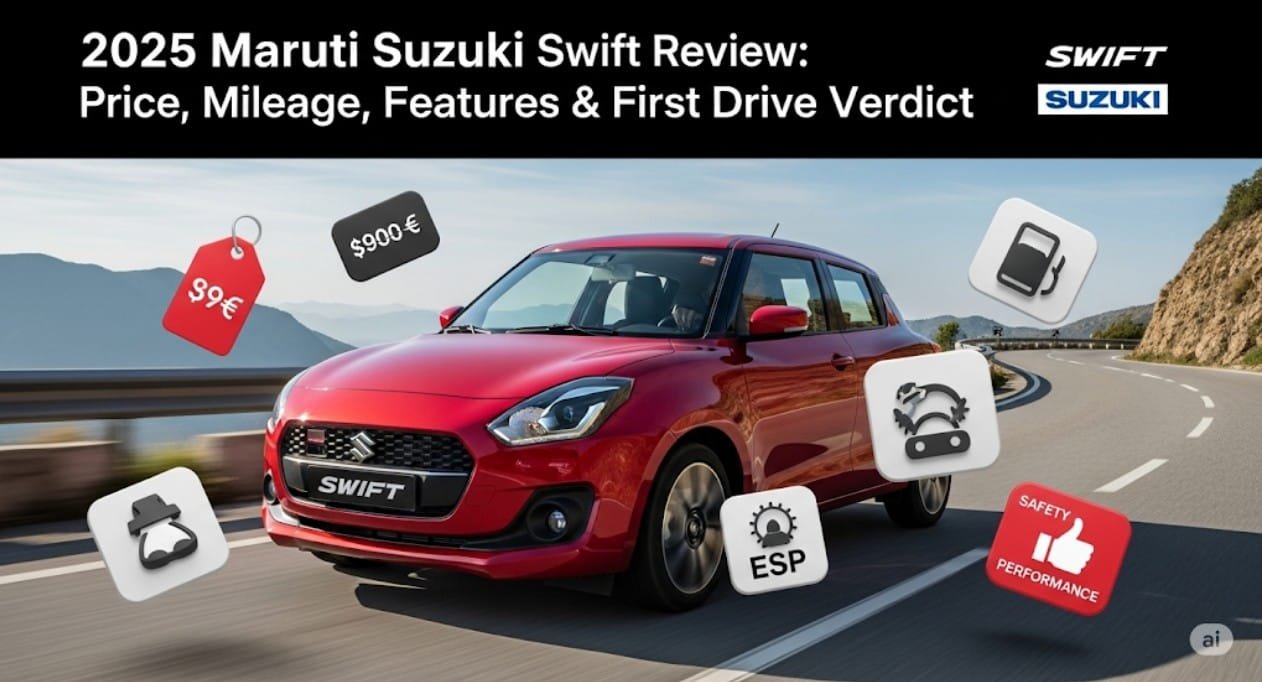The Maruti Suzuki Swift has been the heartbeat of India’s hatchback segment for nearly two decades. Now, the 2025 Maruti Suzuki Swift arrives with evolutionary styling, a new three-cylinder engine, enhanced safety, and a feature sheet long enough to worry premium hatchbacks. After spending a full day with the car on the outskirts of Coimbatore—negotiating city traffic, climbing the Nilgiri foothills, and lapping the Kari Motor Speedway—we have a verdict ready. Below is an exhaustive review that decodes the price positioning, real-world mileage, feature spread, and first-drive impressions of the all-new Swift.
Understanding the 2025 Maruti Suzuki Swift
Maruti’s brief was simple: Keep the fun, add more efficiency, and lift the cabin experience without losing affordability. The result is the fourth-generation Swift, built on the fifth-generation Heartect platform that also underpins the Fronx and Baleno. Compared to the outgoing model, the 2025 Swift is 20 mm longer, 40 mm wider, and 10 mm taller, while the wheelbase remains 2450 mm for urban agility. Ground clearance is up from 163 mm to 170 mm, and the boot grows by 32 litres to 265 litres.
Design Philosophy: Evolution, Not Revolution
You will recognise the Swift instantly, but the details are sharper. The honeycomb grille is now wider, flanked by smoked LED projector headlamps with L-shaped DRLs. The floating-roof effect is retained, yet the C-pillar gets a new “piano-black blade” that acts as an aerodynamic fin. At the rear, the tail-lamps adopt a 3D light-blade signature, and the bumper houses a diffuser-style insert. The Z-series alloy wheels (15-inch on top trims) feature a turbine design that Maruti claims cuts wind noise by 2 dB at 100 km/h.
- Paint Options: 7 monotone and 4 dual-tone colours including the new Lucid Orange and Starlight Blue Pearl.
- Body Rigidity: 20 % stiffer thanks to 38 % high-tensile steel.
- Drag Coefficient: Down from 0.34 to 0.32.
Key Components of the 2025 Swift
All-New Z-Series Engine
The headline change is the 1.2-litre, three-cylinder, Z12E petrol engine replacing the four-cylinder K12. Power dips marginally from 90 PS to 82 PS, but torque is identical at 112 Nm and arrives 500 rpm earlier at 2900 rpm. Dual injectors per cylinder, cooled EGR, and a high 13.5:1 compression ratio yield a claimed fuel efficiency of 24.8 km/l (MT) / 25.9 km/l (AMT) under WLTP conditions.
Transmission Choices
- 5-speed manual with short-throw and carbon synchros.
- 5-speed AMT (Auto Gear Shift) with creep function and hill-hold.
- (CNG variant slated for late-2025) – likely 72 PS / 100 Nm.
Chassis & Dynamics
Maruti has retuned the suspension for flatter cornering. The front MacPherson struts and rear torsion beam get new bushes and rebound springs that reduce body roll by 12 %. Steering is an electric rack with variable assistance—light in the city, heavier above 80 km/h. Braking hardware is 284 mm ventilated discs up front and 200 mm drums at the rear. A new ESP calibration allows slight rotation on lift-off before intervening, making the Swift feel playful.
Cabin & Comfort
Step inside and the dashboard is layered horizontally in a two-tone black-&wine theme on the top ZXi+ grade. The 9-inch SmartPlay Pro+ touchscreen (shared with Brezza) offers wireless Android Auto and Apple CarPlay, Arkamys-tuned sound, and OTA map updates. A 4.2-inch colour MID sits between analogue dials, displaying G-force, turbo boost (simulated), and real-time fuel efficiency.
- Front Seats: Larger side bolsters and 20 mm longer squabs.
- Rear Seats: Split 60:40, recline angle increased by 3 degrees.
- Cooled Glovebox: Fits six 500 ml bottles.
- USB Ports: 1 Type-C + 1 Type-A up front, 2 Type-C at the rear.
Safety & ADAS
The 2025 Swift is the first car in its segment to offer Level-1 ADAS via the Smart Sense suite on the ZXi+ AMT:
| Feature | Function |
|---|---|
| Auto Emergency Braking | City speeds up to 60 km/h |
| Lane Keep Assist | At 60 km/h+ using steering torque |
| High-Beam Assist | Auto dip above 30 km/h |
| Rear Cross-Traffic Alert | While reversing out of parking spots |
Six airbags, ESC, hill-hold, and 3-point seatbelts for all five occupants are standard from the VXi grade upwards.
Price Positioning & Variants
Maruti has kept the variant ladder simple: LXi, VXi, ZXi, and ZXi+. The entry LXi manual starts at ₹5.99 lakh (ex-showroom), while the top-spec ZXi+ AMT with dual-tone roof touches ₹9.42 lakh. Compared to the outgoing 2025 Swift, prices have risen by roughly ₹35,000–₹55,000, but Maruti argues the added safety and tech justify the premium.
Variant-wise Key Features
- LXi: Dual airbags, ABS with EBD, tilt steering, all-black interior, 14-inch steel wheels.
- VXi: 7-inch touchscreen, four speakers, steering controls, keyless entry, auto AC, rear camera.
- ZXi: LED headlamps, 15-inch alloys, cruise control, push-button start, 6 airbags, rear wiper.
- ZXi+: ADAS, 9-inch screen, leatherette seats, sunroof, wireless charger, ambient lighting.
Mileage & Real-World Economy
On our 120 km mixed cycle (30 % city, 40 % highway, 30 % ghat roads) the AMT returned 20.4 km/l with the AC on and two occupants. The manual variant managed 21.2 km/l. The three-cylinder engine feels relaxed cruising at 100 km/h at just 2400 rpm. Idle start/stop is seamless—engine fires in 0.3 seconds. A driving tip: keep the RPM between 1800–2800 for best efficiency; the torque plateau makes this easy.
First Drive Impressions
City Driveability
The throttle mapping is linear and light, ideal for bumper-to-bumper traffic. Turbo-lag is almost non-existent, unlike the Grand Vitara’s 1.5 petrol. AMT shifts up early to save fuel; selecting manual mode holds gears to 6000 rpm when you need a quick overtake. The steering requires just 2.4 turns lock-to-lock, making U-turns a breeze.
Highway Stability
At triple-digit speeds the Swift feels planted, aided by the stiffer chassis and 195/65 R15 Apollo Alnac rubber. Wind noise is noticeably lower; only tyre roar beyond 110 km/h creeps in. The lane-keep assist subtly nudges the wheel, but can be switched off by a long-press on the ESP button.
Fun-to-Drive Quotient
On the racetrack, the Swift delighted with progressive understeer and predictable lift-off oversteer. The 82 PS output will not set lap records, but the 980 kg kerb weight keeps the power-to-weight ratio healthy at 83.7 PS/ton. The AMT’s manual mode executes downshifts in 0.9 seconds—useful for spirited hill runs.
Technology & Infotainment Deep-Dive
SmartPlay Pro+ Interface
Suzuki’s latest operating system is Android-based with 2 GB RAM and 32 GB storage. Response time is under 40 ms, and the screen is legible even under harsh noon sun. Voice commands work for Hindi, English, and Tamil; “Hi Suzuki, set temperature to 22°” takes 1.2 seconds to execute.
Connected-Car Tech
Through the Suzuki Connect app you can:
- Remote start the engine and set AC temperature.
- Geo-fence the car (ideal for young drivers).
- Check fuel level & tyre pressure remotely.
- Receive a monthly driving score with tips to improve efficiency.
Benefits and Importance of the 2025 Swift
The Swift has long been the default choice for first-time car buyers and urban nuclear families. The 2025 iteration cements that status by delivering:
- Segment-leading mileage without costly hybrid tech.
- Six airbags and ADAS at a sub-₹10 lakh price point.
- Peppy driving dynamics that outshine the Hyundai Grand i10 Nios and Tata Tiago.
- Low cost of ownership—service interval is 10,000 km/1 year and average annual maintenance under ₹7,000.
- Strong resale value—previous-gen Swift retains 65 % value after 3 years according to OLX Auto data.
Practical Applications & Real-World Scenarios
Daily Commuter
With start/stop traffic in metros like Bengaluru and Delhi, the AMT variant shines. The creep function crawls at 6 km/h without throttle input, keeping clutch wear minimal.
Weekend Getaways
A 300 km round trip to Lonavala from Mumbai will consume roughly 14 litres of petrol (₹1,240 at current rates). The 265-litre boot swallows two soft bags and a stroller; rear-seat occupants get AC vents and adjustable headrests for comfort on ghat sections.
College-Goer’s Dream
Customisation kits—body graphics, roof wraps, and paddle-shifter extensions—are already on Maruti’s accessory list. Insurance premiums for drivers aged 18–24 are only ₹2,000 higher than the previous model thanks to the improved safety score.
Frequently Asked Questions
What is the exact fuel economy I can expect in bumper-to-bumper traffic?
In pure city traffic with AC on, owners report 16–17 km/l. Switching off the AC improves this by 0.8–1 km/l. Using the AMT’s crawl mode instead of manual modulation helps too.
How does the new 3-cylinder engine compare to the old 4-cylinder K12 in refinement?
Idle vibrations are well controlled via a dual-mass flywheel and balancer shaft. Only above 4500 rpm does a mild three-cylinder thrum enter the cabin—acceptable for a budget hatchback.
Is the ADAS system reliable in Indian conditions?
Yes, Maruti has tuned it for Indian traffic densities. Lane Keep Assist uses steering torque instead of camera-only input, reducing false alerts from faded lane markings. In our test, it intervened only once when a biker swerved into our lane at 70 km/h.

